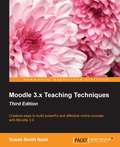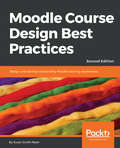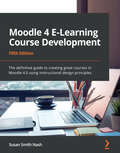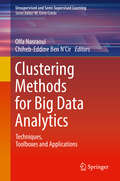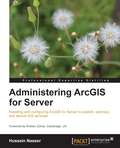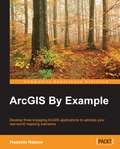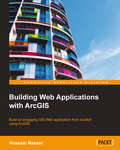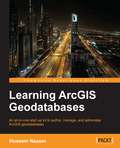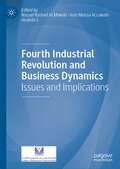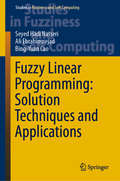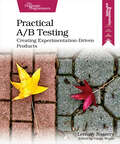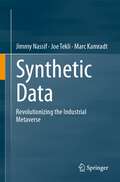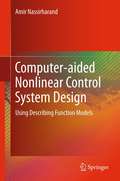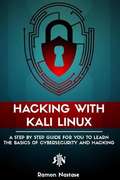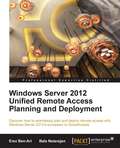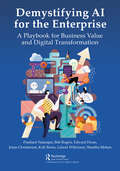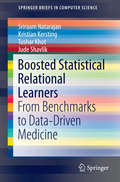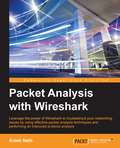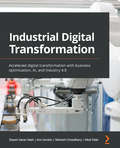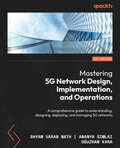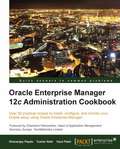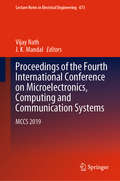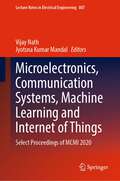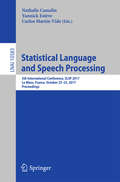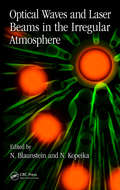- Table View
- List View
Moodle 3.x Teaching Techniques - Third Edition
by Susan Smith NashCreative ways to build powerful and effective online courses with Moodle 3.0 About This Book * Unleash your teaching talents and develop exciting, dynamic courses * Put together effective online courses that motivate students from all backgrounds, generations, and learning styles * Find powerful insights into developing more successful and educational courses Who This Book Is For If you want to unleash your teaching talents and develop exciting, dynamic courses that really get students moving forward, then this book is for you. Experienced Moodlers who want to upgrade to Moodle 3.0 will find powerful insights into developing more successful and educational courses. What You Will Learn * Create a dynamic learning environment using different techniques * Motivate your students to collaborate and demonstrate what they are learning and to create projects together * Develop materials you can re-use in your future courses * Create online workshops and galleries for your students to make presentations about what they have learned * Engage your students in team work that helps them connect course content with their experiences and prior learning * Develop high-quality courses that will last to create a personal inventory you can use and re-use In Detail Moodle, the world's most popular, free open-source Learning Management System (LMS) has released several new features and enhancements in its latest 3.0 release. More and more colleges, universities, and training providers are using Moodle, which has helped revolutionize e-learning with its flexible, reusable platform and components. This book brings together step-by-step, easy-to-follow instructions to leverage the full power of Moodle 3 to build highly interactive and engaging courses that run on a wide range of platforms including mobile and cloud. Beginning with developing an effective online course, you will write learning outcomes that align with Bloom's taxonomy and list the kinds of instructional materials that will work given one's goal. You will gradually move on to setting up different types of forums for discussions and incorporating multi-media from cloud-base sources. You will then focus on developing effective timed tests, self-scoring quizzes while organizing the content, building different lessons, and incorporating assessments. Lastly, you will dive into more advanced topics such as creating interactive templates for a full course by focussing on creating each element and create workshops and portfolios which encourage engagement and collaboration Style and approach With clear, step-by-step instructions, this book helps you develop good, solid, dynamic courses that will last by making sure that your instructional design is robust, and that they are built around satisfying learning objectives and course outcomes. Packed with plenty of screenshots and practical examples, you will get solid understanding of developing courses that are a success in the real world.
Moodle Course Design Best Practices: Design and develop outstanding Moodle learning experiences, 2nd Edition
by Susan Smith NashFast-paced guide for designing effective Moodle courses; experiment with Moodle’s features for free using MoodleCloudKey FeaturesApply principles of instructional design to create great Moodle learning experiencesEnhance collaboration and spur creativity with MoodleBring together instructional materials, social interaction, and student management functions in your coursesBook DescriptionMoodle is a leading virtual learning environment for your online course. This book incorporates the principles of instructional design, showing you how to apply them to your Moodle courses. With this guidance, you will develop and deploy better courses, content, and assessments than ever.This book will guide you as you learn how to build and incorporate many different types of course materials and dynamic activities. You will learn how to improve the structure and presentation of resources, activities, and assessments. All this will help you to create better for self-led courses, instructor-led courses, and courses for collaborative groups. The use of multimedia features to enhance your Moodle courses is also explained in this book.Our goal is to encourage creativity, and the free MoodleCloud hosting option is an ideal place for teachers, students, trainers, and administrators to jump in and play with all the new features, which include powerful new plug-ins, new resources, and activities.Moodle can be your sandbox as well as your castle of learning! With this book, you will build learning experiences that will last your learners’ lifetimes.What you will learnBuild a course structure that fits your goalsDesign a unique appearanceManage the resources and activitiesTips for better organization of your course contentSelect and set up assessmentsInclude effective instructional strategiesIncorporate competency frameworksRun and archive webinarsMotivate learners by incorporating badgesExplore MoodleCloudWho this book is forIf you create courses with Moodle, this book is for you. It can be used by teachers, instructors, training managers, Moodle administrators, instructional technologists, instructional designers, and e-learning entrepreneurs. Prior experience with Moodle will be helpful.
Moodle 4 E-Learning Course Development: The definitive guide to creating great courses in Moodle 4.0 using instructional design principles, 5th Edition
by Susan Smith Nash William RiceLeverage Moodle 4.0's improved UX features and new tools to create effective courses in today's competitive world of online learning, including blended live and on-demand deliveryKey FeaturesDesign courses that are easy to navigate and have easy-to-use productivity toolsEffectively incorporate text, audio, video, and graphics that are ADA compliant and meet the needs of all kinds of learnersBuild the best assessment tools for your learning objectivesBook DescriptionMoodle 4.0 maintains its flexible, powerful, and easy-to-use platform while adding impressive new features to enhance the user experience for student success.This updated edition addresses the opportunities that come with a major update in Moodle 4.0. You'll learn how to determine the best way to use the Moodle platform's new features and configure your courses to align with your overall goals, vision, and even accreditation review needs. You'll discover how to plan an effective course with the best mix of resources and engaging assessments that really show what the learner has accomplished, and also keep them engaged and interested. This book will show you how to ensure that your students enjoy their collaborations and truly learn from each other. You'll get a handle on generating reports and monitoring exactly how the courses are going and what to do to get them back on track. While doing this, you can use Moodle 4.0's new navigation features to help keep students from getting “lost.” Finally, you'll be able to incorporate functionality boosters and accommodate the changing needs and goals of our evolving world.By the end of this Moodle book, you'll be able to build and deploy your educational program to align with learning objectives and include an entire array of course content.What you will learnBuild courses that emphasize the achievement of learning objectivesWrite a variety of effective quizzes that can be taken online and offlineMake the most of the navigation and user experience improvements made to Moodle 4.0Build courses that reflect current interactive teaching practices, including hybrid learning with web conferencingOptimize all kinds of content – text, graphics, audio, video, and recorded webcastsEncourage student engagement and collaborationIncorporate functionality builders for more responsive and adaptive learningWho this book is forThis book is for novice as well as experienced course developers who want to incorporate Moodle 4.0's powerful features and make life easier for students, instructors, and administrators. The powerful and flexible Moodle platform will also help with accreditation and for deploying across devices to people in diverse situations.
Clustering Methods for Big Data Analytics: Techniques, Toolboxes and Applications (Unsupervised and Semi-Supervised Learning)
by Olfa Nasraoui Chiheb-Eddine Ben N'CirThis book highlights the state of the art and recent advances in Big Data clustering methods and their innovative applications in contemporary AI-driven systems. The book chapters discuss Deep Learning for Clustering, Blockchain data clustering, Cybersecurity applications such as insider threat detection, scalable distributed clustering methods for massive volumes of data; clustering Big Data Streams such as streams generated by the confluence of Internet of Things, digital and mobile health, human-robot interaction, and social networks; Spark-based Big Data clustering using Particle Swarm Optimization; and Tensor-based clustering for Web graphs, sensor streams, and social networks. The chapters in the book include a balanced coverage of big data clustering theory, methods, tools, frameworks, applications, representation, visualization, and clustering validation.
Administering ArcGIS for Server
by Hussein NasserThis book is a practical, step-by-step tutorial providing a complete reference guide to the setup, installation, and administration of ArcGIS Server technology. If you are a GIS user, analyst, DBA, or programmer with a basic knowledge of ESRI GIS, then this book is for you.
ArcGIS By Example
by Hussein NasserDevelop three engaging ArcGIS applications to address your real-world mapping scenarios About This Book * Design, build and run ArcGIS applications using ArcObjects SDK * Extend ArcGIS objects and use add -ins to deploy applications on top of ArcGIS * An example-centric practical guide to help you understand mapping scenarios with ArcGIS Who This Book Is For If you are an application developer and wish to enhance your skills for the GIS domain with ArcGIS, then this book is for you. Previous experience with ArcGIS is not required. What You Will Learn * Use essential ArcGIS code to query geodatabases * Communicate with ArcGIS maps, with the help of critical designing and optimisation tips * Highlight and interact with objects on your map * Query ArcGIS geodatabases with related data to display your information on ArcGIS * Edit your underlying geodatabase * Explore strategies for the adaptation of various types of spatial analysis techniques into the GIS framework * Analyze tools for Geographical Information Systems and remote sensing * Experience ArcGIS's advanced tools for manipulation of shapefiles and geodatabases In Detail ArcGIS is a geographic information system (GIS) for working with maps and geographic information. It is considered the turnkey solution to creating and sharing interactive maps. ArcGIS is designed to work the way you work. With nothing to install and set up, ArcGIS helps you make your work productive from day one. The book covers the design and development of three ArcGIS applications to guide the readers in crafting their own GIS solution as per their requirements. The book begins by giving you a refresher on the concepts of ArcGIS. Without wasting any time, you'll begin with developing your first ArcGIS application. You will be developing a cell tower analysis tool. Following this, you will be guided through mapping signal strength and real - time manoeuvring in your GIS system. You will then move on to the second application of the book: a restaurant mapping system. The application will allow tourists to browse restaurants on a map, according to their preferences. Next, you will learn how to work with reviews and ratings and also cover some of the advanced searching options offered by ArcGIS. You will then make use of advanced ArcObjects to develop your third application: an excavation planning manager. The book will conclude by teaching you how work out excavation cost calculations and also saving and retrieving your excavation designs. Style and approach The book offers an enhanced way of learning ArcGIS, through the design and development of three applications throughout its length. In addition to this the book also covers features that you can add to your application as you develop each one covered in the book.
Building Web Applications with ArcGIS
by Hussein NasserIf you are a GIS user or a web programmer, this book is for you. This book is also intended for all those who have basic web development knowledge with no prior experience of ArcGIS and are keen on venturing into the world of ArcGIS technology. The book will equip you with the skills to comfortably start your own ArcGIS web development project.
Learning ArcGIS Geodatabases
by Hussein NasserThis is a solution-based book, showcasing the real power of ArcGIS Geodatabase by following a real-world, example-based approach. This book is aimed at geospatial developers who want to work with ArcGIS geodatabases as well as manage them. Having knowledge of building a geodatabase from scratch isn't a must; Learning ArcGIS Geodatabases is ideal for those who want to use ArcGIS geodatabase for the first time, or for those who want to migrate from their existing legacy database to a geodatabase.
Fourth Industrial Revolution and Business Dynamics: Issues and Implications
by Nasser Rashad Al Mawali Anis Moosa Al Lawati Ananda SThe book explains strategic issues, trends, challenges, and future scenario of global economy in the light of Fourth Industrial Revolution. It consists of insightful scientific essays authored by scholars and practitioners from business, technology, and economics area. The book contributes to business education by means of research, critical and theoretical reviews of issues in Fourth Industrial Revolution.
Fuzzy Linear Programming: Solution Techniques and Applications (Studies in Fuzziness and Soft Computing #379)
by Seyed Hadi Nasseri Ali Ebrahimnejad Bing-Yuan CaoThis book presents the necessary and essential backgrounds of fuzzy set theory and linear programming, particularly a broad range of common Fuzzy Linear Programming (FLP) models and related, convenient solution techniques. These models and methods belong to three common classes of fuzzy linear programming, namely: (i) FLP problems in which all coefficients are fuzzy numbers, (ii) FLP problems in which the right-hand-side vectors and the decision variables are fuzzy numbers, and (iii) FLP problems in which the cost coefficients, the right-hand-side vectors and the decision variables are fuzzy numbers. The book essentially generalizes the well-known solution algorithms used in linear programming to the fuzzy environment. Accordingly, it can be used not only as a textbook, teaching material or reference book for undergraduate and graduate students in courses on applied mathematics, computer science, management science, industrial engineering, artificial intelligence, fuzzy information processes, and operations research, but can also serve as a reference book for researchers in these fields, especially those engaged in optimization and soft computing. For textbook purposes, it also includes simple and illustrative examples to help readers who are new to the field.
Practical A/B Testing: Creating Experimentation-driven Products
by Leemay NasseryWhether you're a catalyst for organizational change or have the support you need to create an engineering culture that embraces A/B testing, this book will help you do it right. The step-by-step instructions will demystify the entire process, from constructing an A/B test to breaking down the decision factors to build an engineering platform. When you're ready to run the A/B test of your dreams, you'll have the perfect blueprint.With smart, tactful approaches to orchestrating A/B testing on a product, you'll quickly discover how to reap all the benefits that A/B testing has to offer - benefits that span your users, your product, and your team. Take the reins today, and be the change you want to see in your engineering and product organizations.Develop a hypothesis statement that's backed with metrics that demonstrate if your prediction for the experiment is correct. Build more inclusive products by leveraging audience segmentation strategies and ad-hoc post analysis to better understand the impact of changes on specific user groups. Determine which path is best for your team when deciding whether to go with a third-party A/B test framework or to build the A/B testing platform in-house. And finally, learn how to cultivate an experimentation-friendly culture within your team.Leverage the A/B testing methodology to demonstrate the impact of changes on a product to your users, your key business metrics, and the way your team works together. After all, if you aren't measuring the impact of the changes you make, how will you know if you're truly making improvements?
Synthetic Data: Revolutionizing the Industrial Metaverse
by Jimmy Nassif Joe Tekli Marc KamradtThe book concentrates on the impact of digitalization and digital transformation technologies on the Industry 4.0 and smart factories, how the factory of tomorrow can be designed, built, and run virtually as a digital twin likeness of its real-world counterpart, before the physical structure is actually erected.It highlights the main digitalization technologies that have stimulated the Industry 4.0, how these technologies work and integrate with each other, and how they are shaping the industry of the future.It examines how multimedia data and digital images in particular are being leveraged to create fully virtualized worlds in the form of digital twin factories and fully virtualized industrial assets. It uses BMW Group’s latest SORDI dataset (Synthetic Object Recognition Dataset for Industry), i.e., the largest industrial images dataset to-date and its applications at BMW Group and Idealworks, as one of the main explanatory scenarios throughout the book.It discusses the need of synthetic data to train advanced deep learning computer vision models, and how such datasets will help create the “robot gym” of the future: training robots on synthetic images to prepare them to function in the real world.
Computer-aided Nonlinear Control System Design: Using Describing Function Models
by Amir NassirharandA systematic computer-aided approach provides a versatile setting for the control engineer to overcome the complications of controller design for highly nonlinear systems. Computer-aided Nonlinear Control System Design provides such an approach based on the use of describing functions. The text deals with a large class of nonlinear systems without restrictions on the system order, the number of inputs and/or outputs or the number, type or arrangement of nonlinear terms. The strongly software-oriented methods detailed facilitate fulfillment of tight performance requirements and help the designer to think in purely nonlinear terms, avoiding the expedient of linearization which can impose substantial and unrealistic model limitations and drive up the cost of the final product. Design procedures are presented in a step-by-step algorithmic format each step being a functional unit with outputs that drive the other steps. This procedure may be easily implemented on a digital computer with example problems from mechatronic and aerospace design being used to demonstrate the techniques discussed. The author's commercial MATLAB®-based environment, available separately from insert URL here, can be used to create simulations showing the results of using the computer-aided control system design ideas characterized in the text. Academic researchers and graduate students studying nonlinear control systems and control engineers dealing with nonlinear plant, particularly mechatronic or aerospace systems will find Computer-aided Nonlinear Control System Design to be of great practical assistance adding to their toolbox of techniques for dealing with system nonlinearities. A basic knowledge of calculus, nonlinear analysis and software engineering will enable the reader to get the best from this book.
Hacking With Kali Linux: A Step By Step Guide For You To Learn The Basics Of Cybersecurity And Hacking (Cybersecurity And Hacking)
by Ramon NastaseThis book will show you how Hacking works. You will have a chance to understand how attackers gain access to your systems and steal information. Also, you will learn what you need to do in order to protect yourself from all kind of hacking techniques.
Windows Server 2012 Unified Remote Access Planning and Deployment
by Bala Natarajan Erez Ben-Ari"Windows Server 2012 Unified Remote Access Planning and Deployment" is a quick start tutorial full of step-by-step instructions to guide you through planning and deploying Unified Remote Access; the successor to DirectAccess. If you are a System Administrator or Engineer who has strong knowledge of networking and deployment for the Microsoft family of operating systems and software, then "Windows Server 2012 Unified Remote Access Planning and Deployment" is for you. You should have a sound understanding of TCP/IP networking, as well as deploying and supporting Windows Server and Client operating systems.
Demystifying AI for the Enterprise: A Playbook for Business Value and Digital Transformation
by Prashant Natarajan Bob Rogers Edward Dixon Jonas Christensen Kirk Borne Leland Wilkinson Shantha MohanArtificial intelligence (AI) in its various forms –– machine learning, chatbots, robots, agents, etc. –– is increasingly being seen as a core component of enterprise business workflow and information management systems. The current promise and hype around AI are being driven by software vendors, academic research projects, and startups. However, we posit that the greatest promise and potential for AI lies in the enterprise with its applications touching all organizational facets. With increasing business process and workflow maturity, coupled with recent trends in cloud computing, datafication, IoT, cybersecurity, and advanced analytics, there is an understanding that the challenges of tomorrow cannot be solely addressed by today’s people, processes, and products. There is still considerable mystery, hype, and fear about AI in today’s world. A considerable amount of current discourse focuses on a dystopian future that could adversely affect humanity. Such opinions, with understandable fear of the unknown, don’t consider the history of human innovation, the current state of business and technology, or the primarily augmentative nature of tomorrow’s AI. This book demystifies AI for the enterprise. It takes readers from the basics (definitions, state-of-the-art, etc.) to a multi-industry journey, and concludes with expert advice on everything an organization must do to succeed. Along the way, we debunk myths, provide practical pointers, and include best practices with applicable vignettes. AI brings to enterprise the capabilities that promise new ways by which professionals can address both mundane and interesting challenges more efficiently, effectively, and collaboratively (with humans). The opportunity for tomorrow’s enterprise is to augment existing teams and resources with the power of AI in order to gain competitive advantage, discover new business models, establish or optimize new revenues, and achieve better customer and user satisfaction.
Boosted Statistical Relational Learners: From Benchmarks to Data-Driven Medicine (SpringerBriefs in Computer Science)
by Sriraam Natarajan Kristian Kersting Tushar Khot Jude ShavlikThis SpringerBrief addresses the challenges of analyzing multi-relational and noisy data by proposing several Statistical Relational Learning (SRL) methods. These methods combine the expressiveness of first-order logic and the ability of probability theory to handle uncertainty. It provides an overview of the methods and the key assumptions that allow for adaptation to different models and real world applications. The models are highly attractive due to their compactness and comprehensibility but learning their structure is computationally intensive. To combat this problem, the authors review the use of functional gradients for boosting the structure and the parameters of statistical relational models. The algorithms have been applied successfully in several SRL settings and have been adapted to several real problems from Information extraction in text to medical problems. Including both context and well-tested applications, Boosting Statistical Relational Learning from Benchmarks to Data-Driven Medicine is designed for researchers and professionals in machine learning and data mining. Computer engineers or students interested in statistics, data management, or health informatics will also find this brief a valuable resource.
Packet Analysis with Wireshark
by Anish NathLeverage the power of Wireshark to troubleshoot your networking issues by using effective packet analysis techniques and performing improved protocol analysis About This Book * Gain hands-on experience of troubleshooting errors in TCP/IP and SSL protocols through practical use cases * Identify and overcome security flaws in your network to get a deeper insight into security analysis * This is a fast-paced book that focuses on quick and effective packet captures through practical examples and exercises Who This Book Is For If you are a network or system administrator who wants to effectively capture packets, a security consultant who wants to audit packet flows, or a white hat hacker who wants to view sensitive information and remediate it, this book is for you. This book requires decoding skills and a basic understanding of networking. What You Will Learn * Utilize Wireshark's advanced features to analyze packet captures * Locate the vulnerabilities in an application server * Get to know more about protocols such as DHCPv6, DHCP, DNS, SNMP, and HTTP with Wireshark * Capture network packets with tcpdump and snoop with examples * Find out about security aspects such as OS-level ARP scanning * Set up 802.11 WLAN captures and discover more about the WAN protocol * Enhance your troubleshooting skills by understanding practical TCP/IP handshake and state diagrams In Detail Wireshark provides a very useful way to decode an RFC and examine it. The packet captures displayed in Wireshark give you an insight into the security and flaws of different protocols, which will help you perform the security research and protocol debugging. The book starts by introducing you to various packet analyzers and helping you find out which one best suits your needs. You will learn how to use the command line and the Wireshark GUI to capture packets by employing filters. Moving on, you will acquire knowledge about TCP/IP communication and its use cases. You will then get an understanding of the SSL/TLS flow with Wireshark and tackle the associated problems with it. Next, you will perform analysis on application-related protocols. We follow this with some best practices to analyze wireless traffic. By the end of the book, you will have developed the skills needed for you to identify packets for malicious attacks, intrusions, and other malware attacks. Style and approach This is an easy-to-follow guide packed with illustrations and equipped with lab exercises to help you reproduce scenarios using a sample program and command lines.
Industrial Digital Transformation: Accelerate digital transformation with business optimization, AI, and Industry 4.0
by Shyam Varan Nath Ann Dunkin Mahesh Chowdhary Nital PatelDelve into industrial digital transformation and learn how to implement modern business strategies powered by digital technologies as well as organization and cultural optimizationKey FeaturesIdentify potential industry disruptors from various business domains and emerging technologiesLeverage existing resources to identify new avenues for generating digital revenueBoost digital transformation with cloud computing, big data, artificial intelligence (AI), and the Internet of Things (IoT)Book DescriptionDigital transformation requires the ability to identify opportunities across industries and apply the right technologies and tools to achieve results. This book is divided into two parts with the first covering what digital transformation is and why it is important. The second part focuses on how digital transformation works.After an introduction to digital transformation, you will explore the transformation journey in logical steps and understand how to build business cases and create productivity benefit statements. Next, you'll delve into advanced topics relating to overcoming various challenges. Later, the book will take you through case studies in both private and public sector organizations. You'll explore private sector organizations such as industrial and hi-tech manufacturing in detail and get to grips with public sector organizations by learning how transformation can be achieved on a global scale and how the resident experience can be improved. In addition to this, you will understand the role of artificial intelligence, machine learning and deep learning in digital transformation. Finally, you'll discover how to create a playbook that can ensure success in digital transformation.By the end of this book, you'll be well-versed with industrial digital transformation and be able to apply your skills in the real world.What you will learnGet up to speed with digital transformation and its important aspectsExplore the skills that are needed to execute the transformationFocus on the concepts of Digital Thread and Digital TwinUnderstand how to leverage the ecosystem for successful transformationGet to grips with various case studies spanning industries in both private and public sectorsDiscover how to execute transformation at a global scaleFind out how AI delivers value in the transformation journeyWho this book is forThis book is for IT leaders, digital strategy leaders, line-of-business leaders, solution architects, and IT business partners looking for digital transformation opportunities within their organizations. Professionals from service and management consulting firms will also find this book useful. Basic knowledge of enterprise IT and some intermediate knowledge of identifying digital revenue streams or internal transformation opportunities are required to get started with this book.
Mastering 5G Network Design, Implementation, and Operations: A comprehensive guide to understanding, designing, deploying, and managing 5G networks
by Shyam Varan Nath Ananya Simlai Oguzhan KaraLearn 5G network design and implement advanced apps using standalone, non-standalone, and private 5G networks with expert guidance from industry leadersPurchase of the print or kindle book includes a free eBook in the PDF formatKey FeaturesGain a comprehensive understanding of the 5G end-to-end network architectureBuild a foundation to successfully design, implement, manage, and monetize a 5G networkDesign and deploy innovative applications based on 5G networksBook DescriptionWe are living in an era where ultra-fast internet speed is not a want, but a necessity. As applications continue to evolve, they demand a reliable network with low latency and high speed. With the widespread commercial adoption of driverless cars, robotic factory floors, and AR/VR-based immersive sporting events, speed and reliability are becoming more crucial than ever before. Fortunately, the power of 5G technology enables all this and much more.This book helps you understand the fundamental building blocks that enable 5G technology. You'll explore the unique aspects that make 5G capable of meeting high-quality demands, including technologies that back 5G, enhancements in the air interface, and packet core, which come together to create a network with unparalleled performance. As you advance, you'll discover how to design and implement both 5G macro and private networks, while also learning about the various design and deployment options available and which option is best suited for specific use cases. After that, you'll check out the operational and maintenance aspects of such networks and how 5G works together with fixed wireline and satellite technologies.By the end of this book, you'll understand the theoretical and practical aspects of 5G, enabling you to use it as a handbook to establish a 5G network.What you will learnUnderstand the key aspects and methodology of 5G New Radio and NG-RANGet to grips with Voice over New Radio (VoNR) networksGet started with 5G radio planning along with the 5G air interfaceTake a deep dive into the 5G core network and explore the overall 5G network architectureGain a clear understanding of various 5G deployment optionsExplore network slicing and the role it plays in 5GGet an overview of 5G fixed mobile convergence, autonomous vehicles, and satellite communicationsWho this book is forIf you are a telecom enthusiast or work in this domain and are looking to learn more about building a 5G network bottom–up or an application modernization strategy maker, then this book is for you. It provides a consumable understanding of the technology to network engineers, network architects, and infrastructure decision-makers, helping them excel in their day-to-day work involving 5G technology.
Oracle Enterprise Manager 12c Administration Cookbook
by Tushar Nath Vipul Patel Dhananjay PapdeAs a Packt Cookbook, you can expect this book to be full of useful and practical recipes to common and important tasks faced by professional database administrators. This book is for Oracle Database, Middleware, System, and Infrastructure Administrators. A basic understanding of Oracle Enterprise Manager is needed, as well as being comfortable using command line environments.
Proceedings of the Fourth International Conference on Microelectronics, Computing and Communication Systems: MCCS 2019 (Lecture Notes in Electrical Engineering #673)
by Vijay Nath J. K. MandalThis book presents high-quality papers from the Fourth International Conference on Microelectronics, Computing & Communication Systems (MCCS 2019). It discusses the latest technological trends and advances in MEMS and nanoelectronics, wireless communication, optical communication, instrumentation, signal processing, image processing, bioengineering, green energy, hybrid vehicles, environmental science, weather forecasting, cloud computing, renewable energy, RFID, CMOS sensors, actuators, transducers, telemetry systems, embedded systems and sensor network applications. It includes papers based on original theoretical, practical and experimental simulations, development, applications, measurements and testing. The applications and solutions discussed here provide excellent reference material for future product development.
Microelectronics, Communication Systems, Machine Learning and Internet of Things: Select Proceedings of MCMI 2020 (Lecture Notes in Electrical Engineering #887)
by Vijay Nath Jyotsna Kumar MandalThis volume presents peer-reviewed papers of the First International Conference on Microelectronics, Communication Systems, Machine Learning, and the Internet of Things (MCMI-2020). This book discusses recent trends in technology and advancement in microelectronics, nano-electronics, VLSI design, IC technologies, wireless communications, optical communications, SoC, advanced instrumentations, signal processing, internet of things, machine learning, image processing, green energy, hybrid vehicles, weather forecasting, cloud computing, renewable energy, CMOS sensors, actuators, RFID, transducers, real-time embedded system, sensor network and applications, EDA design tools and techniques, fuzzy logic & artificial intelligence, high-performance computer architecture, AI-based robotics & applications, brain-computer interface, deep learning, advanced operating systems, supply chain development & monitoring, physical systems design, ICT applications, e-farming, information security, etc. It includes original papers based on theoretical, practical, experimental, simulations, development, application, measurement, and testing. The applications and solutions discussed in the book will serve as good reference material for young scholars, researchers, and academics.
Statistical Language and Speech Processing: 5th International Conference, SLSP 2017, Le Mans, France, October 23–25, 2017, Proceedings (Lecture Notes in Computer Science #10583)
by Nathalie Camelin, Yannick Estève and Carlos Martín-VideThis book constitutes the refereed proceedings of the 5th International Conference on Statistical Language and Speech Processing, SLSP 2017, held in Le Mans, France, in October 2017. The 21 full papers presented were carefully reviewed and selected from 39 submissions. The papers cover topics such as anaphora and conference resolution; authorship identification, plagiarism and spam filtering; computer-aided translation; corpora and language resources; data mining and semanticweb; information extraction; information retrieval; knowledge representation and ontologies; lexicons and dictionaries; machine translation; multimodal technologies; natural language understanding; neural representation of speech and language; opinion mining and sentiment analysis; parsing; part-of-speech tagging; question and answering systems; semantic role labeling; speaker identification and verification; speech and language generation; speech recognition; speech synthesis; speech transcription; speech correction; spoken dialogue systems; term extraction; text categorization; test summarization; user modeling. They are organized in the following sections: language and information extraction; post-processing and applications of automatic transcriptions; speech paralinguistics and synthesis; speech recognition: modeling and resources.
Optical Waves and Laser Beams in the Irregular Atmosphere
by Nathan Blaunstein and Natan KopeikaThe book introduces optical wave propagation in the irregular turbulent atmosphere and the relations to laser beam and LIDAR applications for both optical communication and imaging. It examines atmosphere fundamentals, structure, and content. It explains specific situations occurring in the irregular atmosphere and for specific natural phenomena that affect optical ray and laser beam propagation. It emphasizes how to use LIDAR to investigate atmospheric phenomena and predict primary parameters of the irregular turbulent atmosphere and suggests what kinds of optical devices to operate in different atmospheric situations to minimize the deleterious effects of natural atmospheric phenomena.
